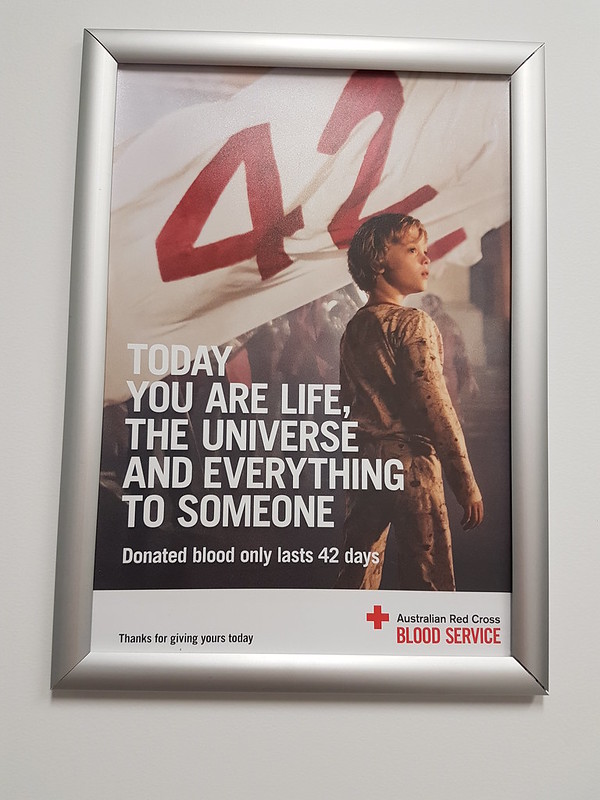Friday, December 21, 2018
do you collect cartons for local studies?
Go and have a look at the Cartongraphy site. Fruit and vegetable boxes are a great way of recording changes in agriculture, and of relevance to local studies.
Tuesday, December 18, 2018
Toil Inntinn - bilingual local studies
An Lanntair has launched a 3 year arts-based ‘Dementia Friendly Community’ project in the Western Isles, in partnership with Life Changes Trust. The project will engage with people who are living with dementia and those in their circle of care, as well as reaching out to the wider Western Isles community, with the intention of building a bi-lingual dementia friendly community that reflects the specific needs of the place and its people (from An Lanntair https://dfclanntair.wordpress.com/about/).
You can read more about the grant here.
This seems an important project which used bilingual information as part of dementia care, but also as part of recording local studies information.
You can read more about the grant here.
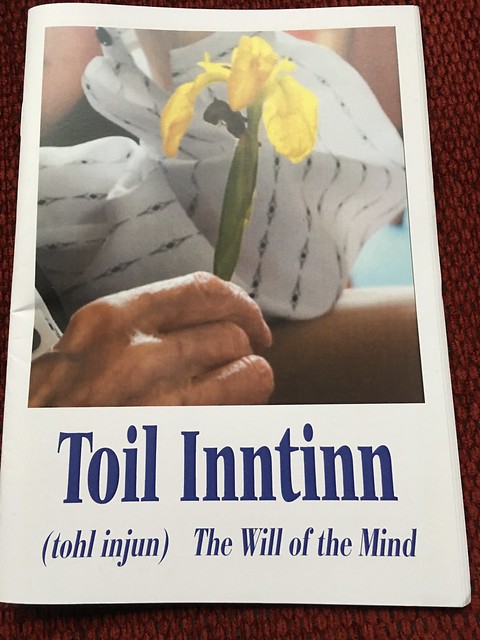 |
| Showing the cover of Toil Inntinn |
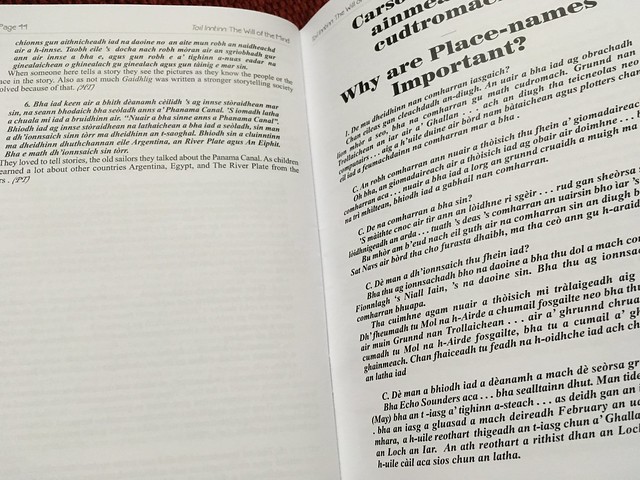 |
| Showing some of the text |
Wednesday, November 7, 2018
A few thoughts on Archiving the unspeakable: silence, memory, and the photographic record in Cambodia by Michelle Caswell
 Archiving the Unspeakable: Silence, Memory, and the Photographic Record in Cambodia by Michelle Caswell
Archiving the Unspeakable: Silence, Memory, and the Photographic Record in Cambodia by Michelle CaswellMy rating: 5 of 5 stars
This book is about the archive of photographs from the Tuol Sleng Prison in Cambodia. These are photographs of people who were killed by the Khmer Rouge. These photographs, while documenting most of the people from one prison, represent a small number of the total people killed during the time the Khmer Rouge were in power.
This book is a detailed exploration of these photographs, how they have been used, and occasionally misused, including one art book which seemed to ignore the fact that these were real people who had been killed. This book also investigated the power of documentation as the approximately 17,000 people killed in the Tuol Sleng Prison in Cambodia is a small percentage of all the deaths during the time of the Khmer Rouge, but because they are documented there is a focus on them. There is an interesting discussion of how they were used during a war crime trial, with Duch, the person on trial arguing that if the person had not been photographed he was not responsible for their death.
There is very interesting discussion about the importance of provenance in archival collections, including the reason for the records being created. In this context these photographs were taken as part of documenting prisoners, only seven people living to actually describe their experiences.
This is a very interesting, and disturbing book to read. The detailed exploration of why the photographs were created and the many ways they have been used provides ways for thinking about other archives, and their potential use. It also highlights the need to collect a range of resources.
This is a useful book to read to think about the social justice implications of archives, and other historical collections such as local studies collections in public libraries as it really encouraged thinking about who is included and who is excluded.
View all my reviews
Monday, October 29, 2018
What does ten years on twitter look like?
I have just reached ten years on twitter. Some of you have been on twitter for longer, some shorter. One way to look at the ten years is by the work of @mhawksey and a twitter archive. August 2013 was peak tweeting for me. It is easy to set up your own twitter archive. There is a video of how to do this. The twitter archive just updates in the background, and is an easy way to look at tweets over time.
My tweeting has changed over time. At first it was only library related, and then I introduced some other areas such the environment. I also follow a wider range of people and organisations including more knitters. What has stayed the same is that I am still a conference tweeter and I still tweet some of my professional reading.
How has your tweeting changed over time?
My tweeting has changed over time. At first it was only library related, and then I introduced some other areas such the environment. I also follow a wider range of people and organisations including more knitters. What has stayed the same is that I am still a conference tweeter and I still tweet some of my professional reading.
How has your tweeting changed over time?
Monday, September 24, 2018
How easy do you make it for people to know the hashtags to share about your library?
I like it when hashtags are easy to find. The top picture shows how the Royal Botanic Gardens, Sydney makes it easy for people to find their hashtag. It is in various places through the gardens. You can see how people are using #rbgsydney.
The picture below shows part of a page from Pompom, a knitting magazine, and each knitted item has its own hashtag. Using the example of #ixchelpullover, you can see, as well as the magazine images, people sharing their own knitting.
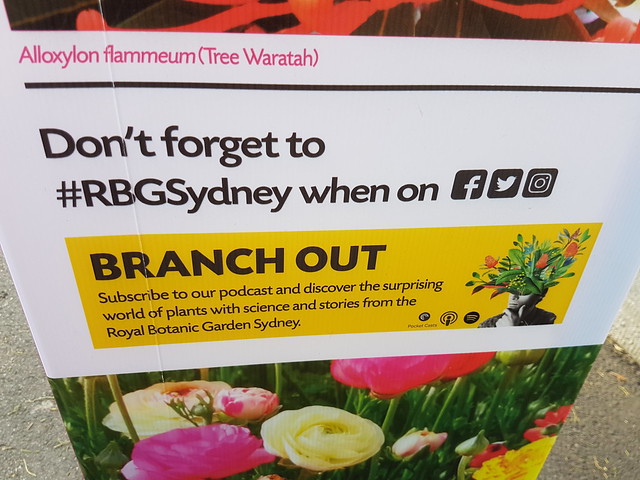 |
| Sign in the Royal Botanic Gardens, Sydney showing the hashtag they are encouraging people to use |
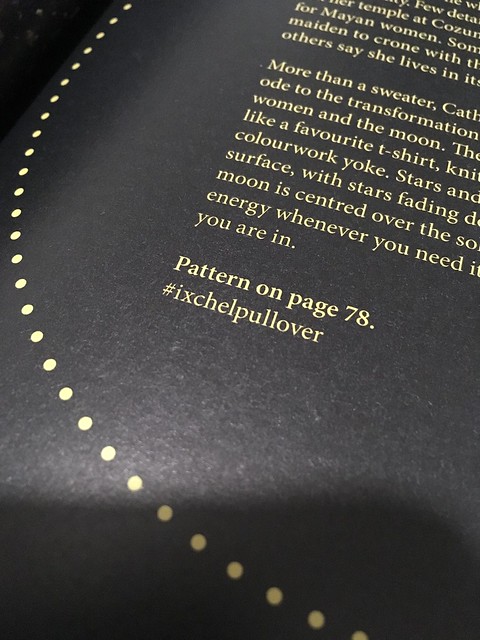 |
| Picture of a page in Pompom magazine, where each knitted item has a hashtag. |
Thursday, August 16, 2018
'don't be complicit in our silencing' powerful call from Sonali Dev for taking action on library collections
This is a powerful speech by Sonali Dev - listen and take action for your collections
Tuesday, August 7, 2018
make sure your local studies collection is inclusive
There has been a lot of discussion about representation in knitting, on Instagram and twitter, following a presentation by Lorna Hamilton-Brown at the recent In the loop #intheloop10 conference. Videos like the one below are an example of people sharing stories so that history is more accurate. I am really enjoying these stories. I am hoping some libraries will collect them.
These stories may also be under represented in public libraries. You may only be collecting local studies information about part of your community, and not, for example recent migrants, people with a disability, or Aboriginal and Torres Strait Islander people. These are just some examples of people who may not be having their stories and histories included.
The talks from In the loop 10 will be available to watch online soon.
Also - are your library knitting groups inclusive?
A post shared by Lorna Hamilton-Brown (@lhamiltonbrown) on
These stories may also be under represented in public libraries. You may only be collecting local studies information about part of your community, and not, for example recent migrants, people with a disability, or Aboriginal and Torres Strait Islander people. These are just some examples of people who may not be having their stories and histories included.
The talks from In the loop 10 will be available to watch online soon.
Also - are your library knitting groups inclusive?
Tuesday, July 31, 2018
How does your library acknowledge Indigenous people?
I am more frequently seeing signs like this outside banks, however, I am not consistently seeing acknowledgements at libraries. I was wondering how people are addressing this and how you are working with local Aboriginal and Torres Strait Islander people to do so?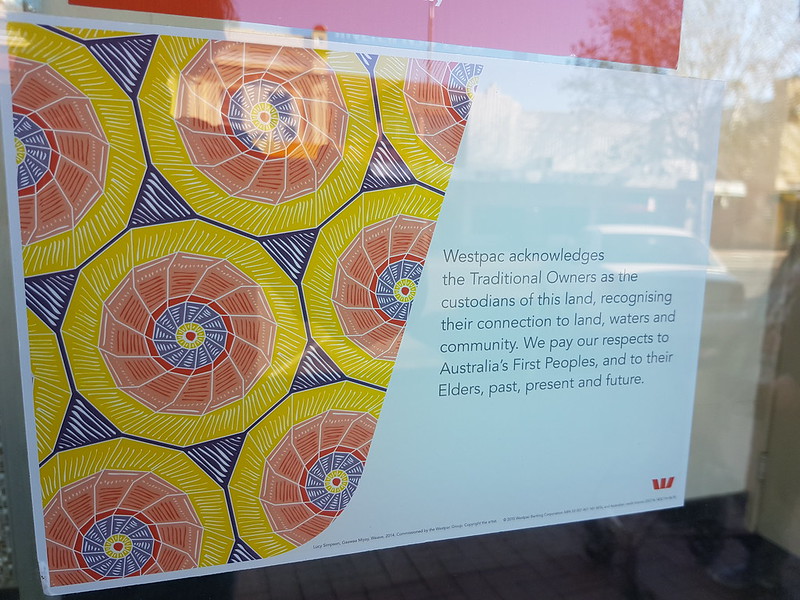

Tuesday, June 12, 2018
A few thoughts on The West Highland Way by Kate Davies
 The West Highland Way by Kate Davies
The West Highland Way by Kate DaviesMy rating: 5 of 5 stars
This is a lovely knitting and local studies book. It takes the West Highland Way in Scotland as the starting point for knitwear design. The book covers the entire West Highland Way, divided into walkable sections. Each of the beautifully photographed areas has a piece of knitwear which was inspired by that specific part of the West Highland Way. Each of these is also clearly photographed. This book is written by a knitter who has walked the West Highland Way, and regularly walks the sections closest to her home.
There are many local stories through this book, and it gives a lovely introduction to the section of Scotland. The patterns looks lovely, although I have yet to start knitting one of then.
The subtitle of this book is 'knit read walk'.
View all my reviews
Wednesday, June 6, 2018
A few thoughts on Folk fashion: understanding homemade clothes by @AmyTwiggerH
 Folk Fashion: Understanding Homemade Clothes by Amy Twigger Holroyd
Folk Fashion: Understanding Homemade Clothes by Amy Twigger HolroydMy rating: 5 of 5 stars
This is a wonderful book exploring homemade clothes, and it is an entertaining read. I read it as my commute reading and it was very engaging. It is based on research and explores making and remaking (a much better word than upcycling). The information from remaking sessions with a several knitters provides crucial information for exploring how people feel about making their own clothes.
It includes sustainability, well being and emotions about making. There is a helpful ten point strategy for supporting and encouraging folk fashion makers. These are points which libraries are well placed to deliver, and some are doing some of them. As it is important to read this book before getting to the ten point strategy, I am not going to include it here.
This books is currently held in eight libraries in Australia (based on information from Trove Australia).
This book has lead me to pull out and old jumper I used to wear and adjust (remake) the length of the sleeves, a 15 minute job and to sew buttons on a knitted vest which had been unfinished for about 15 years.
View all my reviews
Friday, June 1, 2018
a few thoughts on KNITSONIK Stranded Colourwork Playbook by @knitsonik
 KNITSONIK Stranded Colourwork Playbook by Felicity Ford
KNITSONIK Stranded Colourwork Playbook by Felicity FordMy rating: 5 of 5 stars
This is a wonderful book. I have already read and enjoyed the previous book Knitsonik Stranded Colourwork Sourcebook which is a remarkable work highlighting the local studies potential of knitting. This book builds on this with some wonderful examples of how stranded colourwork can reflect and record an area. There is a lovely knitted correspondence, bunting, and an amazing scarf which celebrates the loveliness of bricks in Reading further demonstrating the local studies potential of knitting.
The aim of this book, and Knitsonik Stranded Colourwork Sourcebook is to encourage people to use their own environments as inspiration for stranded coloured knitting. I am a bit of a slow starter in this area however I have started taking more photographs. I am trying to participate in #tarmactuesday but I keep forgetting until Wednesday. So, even though I am not yet reflecting my area in knitting, reading these books has lead to me changing some practices.
While these books are targeting people who knit, they could be interesting for people wanting to think about how to depict their area as there is inspiration for photographers, embroiders, wood carvers and more. As you can tell, I am a fan of this work as it is joyful, practical and inspirational.
View all my reviews
Tuesday, May 22, 2018
a few thoughts on Teaching for Justice: Implementing Social Justice in the Lis Classroom
 Teaching for Justice: Implementing Social Justice in the Lis Classroom by Nicole A Cooke
Teaching for Justice: Implementing Social Justice in the Lis Classroom by Nicole A CookeMy rating: 4 of 5 stars
This is the first Library Juice Press publication I have read. The title may seem to be only relevant for people who are teaching people to be librarians, however, there is much of relevance for library practitioners as the different chapters explore theoretical frameworks as well as teaching. Many of the exercises described by the authors of the different chapters could be applied or modified for a workplace. It is helping me think about professional development to work on, building on some work already being done to address social justice in libraries.
A strong point in this books is about social justice being a key part of every library service. It is part of who is not using the library, who is included in the collections (and this is all collections from those for children to local studies), and who is targeted in programs and services. What languages are collected and have programs or services provided in also matters.
I read this book slowly because it is the kind of book which needs to be read and thought about, and now parts need to be reread.
Each chapters has detailed bibliographical information making additional reading easy to do. This book is written by people in the USA, but there is much of relevance for Australian (and other) library staff.
The book would be useful reading for many library staff. It would be an interesting one for a staff reading group discussion.
My copy now has post-it note flags sticking out from it, some with writing on them for additional prompts. This is why ebooks can be handy, for less messy note taking, but paper is also fine for reading.
View all my reviews
Wednesday, May 9, 2018
a few thoughts on the book Shetland Oo: Wool Textiles Work (and it is a lovely local studies publication)
 Shetland Oo: Wool Textiles Work by Kate Davies
Shetland Oo: Wool Textiles Work by Kate DaviesMy rating: 4 of 5 stars
This is an impressive local studies publication with very beautiful photographs. It is a collaboration between Kate Davies (words) and Tom Barr (photographs) exploring the current wool environment in Shetland. The story of local wool is mostly told through short biographies of people in the whole chain of wool and sheep processing from those who raise the sheep to those who process the wool/leather, and those who spin, knit, design and use wool in other ways.
It is a very interesting look at this part of the world and brings many people into the story of the wool and sheep industry. There is some exploration of the history of wool and knitting on these islands, highlighting the very tough life many of these people have had.
This is a engaging, episodic read and shows how lovely some local studies publications can be.
View all my reviews
Tuesday, April 17, 2018
The meaning of life is 42, but does this sign included or exclude?
Do the signs at your library include or exclude?
This was a sign at the blood bank. I have read The hitchhikers guide to the galaxy (a very long time ago), so I thought I knew the quote it was referring to. I may still work if you have not read/watched it (or at least I think it does), because the key point is how long blood lasts (or at least that is how I read it).
There is a however to this. Because I was taking a photograph in the interview room (you have to answer a lot of questions before you can donate blood, plasma or platelets), this started a discussion with the nurse who had not read the book, seen the film or television series. She was commenting on how excited another donor had been seeing the poster. This made me wonder if it was too niche. I think it works even if you don't know that that many of the words form a quote as the key point is blood lasts 42 days so there needs to be continuing donations. It highlights that there can be many ways to read a sign.
This was a sign at the blood bank. I have read The hitchhikers guide to the galaxy (a very long time ago), so I thought I knew the quote it was referring to. I may still work if you have not read/watched it (or at least I think it does), because the key point is how long blood lasts (or at least that is how I read it).
There is a however to this. Because I was taking a photograph in the interview room (you have to answer a lot of questions before you can donate blood, plasma or platelets), this started a discussion with the nurse who had not read the book, seen the film or television series. She was commenting on how excited another donor had been seeing the poster. This made me wonder if it was too niche. I think it works even if you don't know that that many of the words form a quote as the key point is blood lasts 42 days so there needs to be continuing donations. It highlights that there can be many ways to read a sign.
Tuesday, April 10, 2018
A few thoughts on Algorithms of oppression by @safiyanoble
 Algorithms of Oppression: How Search Engines Reinforce Racism by Safiya Umoja Noble
Algorithms of Oppression: How Search Engines Reinforce Racism by Safiya Umoja NobleMy rating: 5 of 5 stars
This is an amazing book. There are detailed and glowing reviews of this book available elsewhere. These glowing reviews are deserved. I will keep my comments brief, as I want you to read this book, and not my review. Instead I will say, if you use search engines, you should read this book to be more aware of the bias in the tools which you use. If you work in a library and assist clients through using a search engine, you should read this to be more aware of the bias in the tools which you use.
This book, as well as highlighting the research of the author, generously showcases other relevant research about bias in search engines and library catalogues.
It contains strong calls to action for librarians, archivists and information workers, which is also relevant for museum and gallery staff as well. Quoting from location 3081 Now, more than ever, we need libraries, universities, schools, and information resources that will bolster, and further expand democracy for all, rather than shrink the landscape of participation along racial, religious, and gendered lines.
When I checked the holdings on Trove Australia on 7 April, there were two libraries in Australia showing that they have this title.
View all my reviews
Tuesday, April 3, 2018
Instagram and local studies - a project from Reading UK by @Reading_21
This shows a recent student project which has local studies elements. You can read the aim below.
This has great prompts for local studies. You can read more about it here. The following image show the statistics for participation.A post shared by Gracie Price (@reading_21) on
Have a look on twitter and instagram for the hashtag #rdg21 and you will see some lovely local studies images. As you can see from the image below, similar things have been done elsewhere, but it is still something few libraries have tried. It would be interesting to see if you could turn up new photographs to collect as a result of something like this.
A post shared by Orange County Library System (@ocls) on
Thursday, March 8, 2018
wifi now at @RBGSydney
The Royal Botanic Gardens recently announced their wifi.
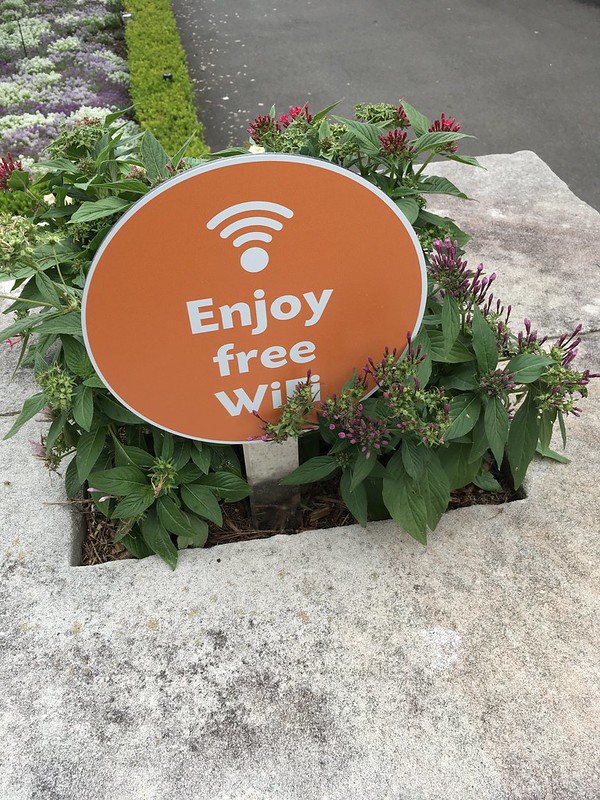
I like the way they made it easy to find.
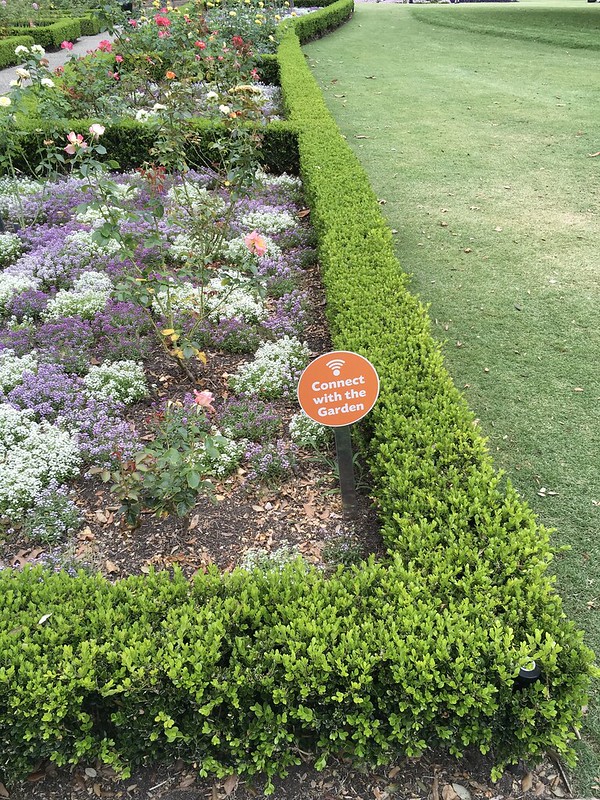
Hopefully your library is making it easy for people to know you have free wifi.

I like the way they made it easy to find.

Hopefully your library is making it easy for people to know you have free wifi.
Tuesday, February 6, 2018
I am having fun with Trove bots - thanks to @wragge
First, go and read Trove bots for all by @wragge. I have been having fun playing with this. I have made a tag bot for the word cake (and now I need to tag a lot more articles in Trove with cake) which is @trovebotcake. I tried another one for knitting @troveknitbot.
I have tried the Trove bot for newspapers and have done The land - @Trovelandbot, and combined bot for Dutch Weekly and Dutch Australian Weekly, @TroveDutchbot.
This is really fun, as you can tell by what I am doing, and I am much faster. I will stop here, for now, but go and make your own Trove bot now.
I have tried the Trove bot for newspapers and have done The land - @Trovelandbot, and combined bot for Dutch Weekly and Dutch Australian Weekly, @TroveDutchbot.
This is really fun, as you can tell by what I am doing, and I am much faster. I will stop here, for now, but go and make your own Trove bot now.
Tuesday, January 30, 2018
Knitting inspired by Tempestry project, local studies, craftivism and datavisualisation
I found out about the Tempestry project a few month ago when it was shared through Instagram. I can't remember who shared it, and so can not give credit. The purpose is knitting weather charts showing maximum temperatures, to visualise climate change. You can read about it here. If you are interested, the simplest way to participate is to go to the Etsy store and the nice people at Tempestry will send you the wool in the right colours and quantities.
The following information is if you are seeking another solution and want to use Australian wool. I will say it again, if you are interested, the simplest way to participate is to go to the Etsy store and the nice people at Tempestry will send you the wool in the right colours and quantities.
I wrote to them before I started because I wanted to see if it was okay to use their idea with Australian wool, and I appreciate their kindness and helpfulness. I emailed them because for the past few years I have only been buying Australian made knitting fibre*. I buy Australian wool because I want to support Australian wool (cotton, alpaca...) and do not want to this industry to go under. The people at Tempestry were very understanding and sent high resolution jpegs so I could colour match. They even sent me the chart of Fahrenheit to Celsius so I could match all the temperatures exactly. I will say it again, if you are interested, the simplest way to participate is to go to the Etsy store and the nice people at Tempestry will send you the wool in the right colours and quantities.
I used two different wool brands, Nundle and Bendigo. The chart below shows the colours next to the colour ranges.
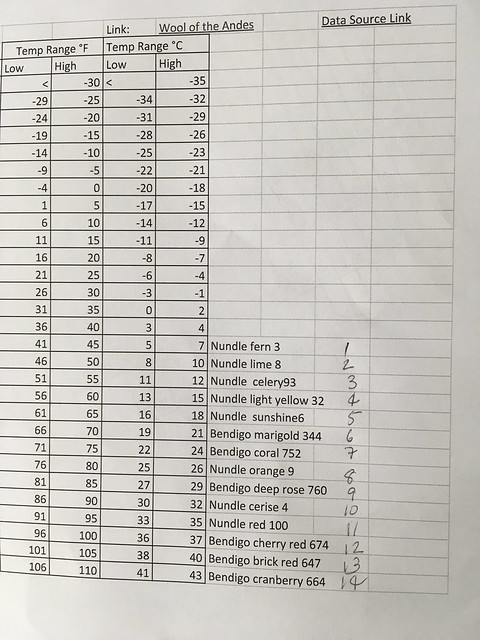
I found some aspects easier to hand write. I attached stickers with the relevant numbers to each ball of wool.
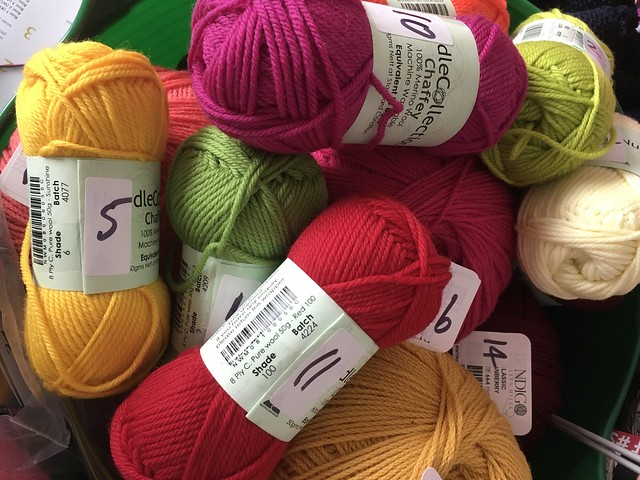
This makes it easy for matching the right colour with the temperature chart. I discovered the joys of climate data online (and it really is fun). The Australian Bureau of Meteorology has a lovely data site.
The chart below shows the number of the wool colour next to the temperature. I chose Inverell, NSW in 2013 and used moss stitch.
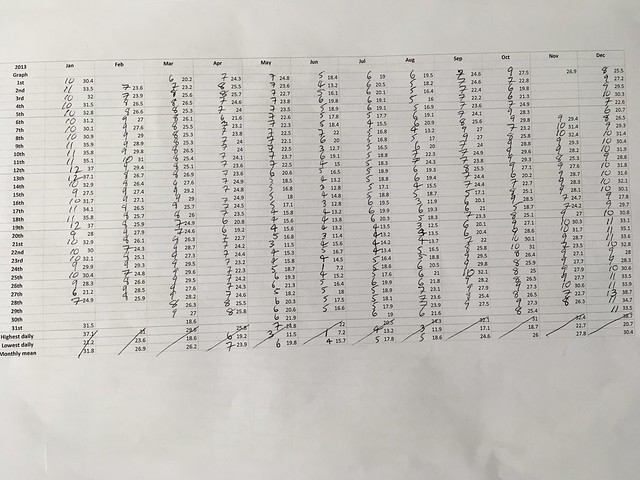
This next photograph shows the start of the knitting.
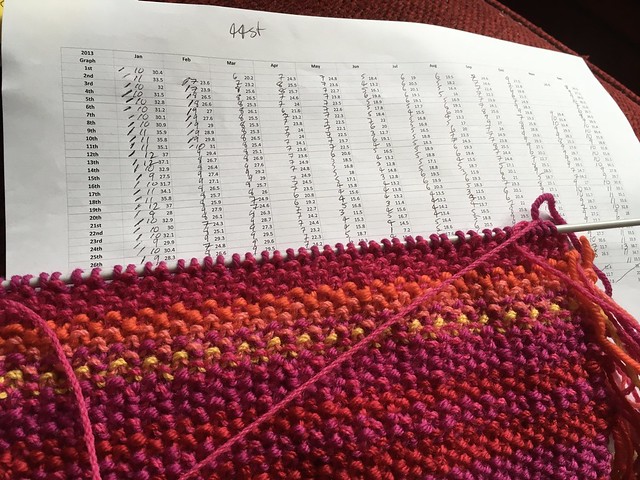
As you can see, I was not tidying the ends as I went. This was an experiment. While I have done multicoloured knitting in the past it has been jumpers or beanies where the ends are inside, not a scarf like this.
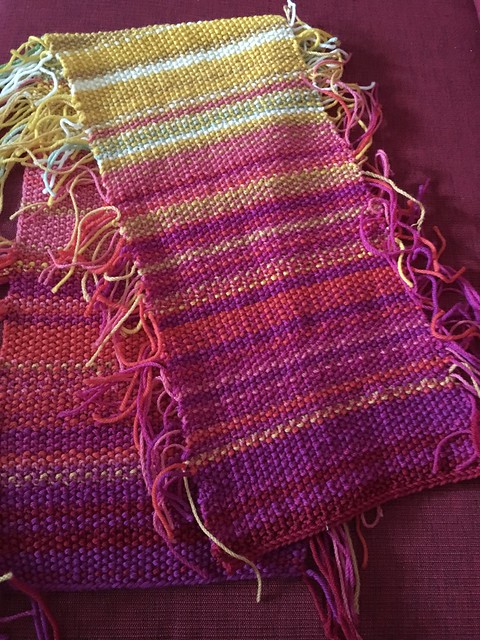
I did start tidying the ends (which you can see if you look closely to the top most section of knitting, but decided it was not worth it. This will work as a scarf with a sideways fringe.
I have started knitting Sydney, NSW 2017 temperatures, and am trying a method of knitting in the ends, but so far that seems to be just meaning that there is a definite front and back. The back being where the knitted ends are not as invisible as they should be.
I like this project because it is local studies, craftivism and datavisualisation. Local studies because each length of knitting records the maximum temperatures for a specific location for a specific year. Craftivism because it is using craft for activism, in this instance for climate change. Datavisualisation because it is showing the maximum temperatures for one year, and functions as a knitted graph.
I would really like to thank the people at the Tempestry Project for being willing for me to work with Australian wool for this project.
*I have to qualify this because before the last few years I was *mostly* buying Australian. This means in my fibre stash I have a range of knitting fibres from various locations around the world. Now I really buy all Australian unless I am in another location and am buying locally produced fibres. You can see all my photographs for this project below.
The following information is if you are seeking another solution and want to use Australian wool. I will say it again, if you are interested, the simplest way to participate is to go to the Etsy store and the nice people at Tempestry will send you the wool in the right colours and quantities.
I wrote to them before I started because I wanted to see if it was okay to use their idea with Australian wool, and I appreciate their kindness and helpfulness. I emailed them because for the past few years I have only been buying Australian made knitting fibre*. I buy Australian wool because I want to support Australian wool (cotton, alpaca...) and do not want to this industry to go under. The people at Tempestry were very understanding and sent high resolution jpegs so I could colour match. They even sent me the chart of Fahrenheit to Celsius so I could match all the temperatures exactly. I will say it again, if you are interested, the simplest way to participate is to go to the Etsy store and the nice people at Tempestry will send you the wool in the right colours and quantities.
I used two different wool brands, Nundle and Bendigo. The chart below shows the colours next to the colour ranges.

I found some aspects easier to hand write. I attached stickers with the relevant numbers to each ball of wool.

This makes it easy for matching the right colour with the temperature chart. I discovered the joys of climate data online (and it really is fun). The Australian Bureau of Meteorology has a lovely data site.
The chart below shows the number of the wool colour next to the temperature. I chose Inverell, NSW in 2013 and used moss stitch.

This next photograph shows the start of the knitting.

As you can see, I was not tidying the ends as I went. This was an experiment. While I have done multicoloured knitting in the past it has been jumpers or beanies where the ends are inside, not a scarf like this.

I did start tidying the ends (which you can see if you look closely to the top most section of knitting, but decided it was not worth it. This will work as a scarf with a sideways fringe.
I have started knitting Sydney, NSW 2017 temperatures, and am trying a method of knitting in the ends, but so far that seems to be just meaning that there is a definite front and back. The back being where the knitted ends are not as invisible as they should be.
I like this project because it is local studies, craftivism and datavisualisation. Local studies because each length of knitting records the maximum temperatures for a specific location for a specific year. Craftivism because it is using craft for activism, in this instance for climate change. Datavisualisation because it is showing the maximum temperatures for one year, and functions as a knitted graph.
I would really like to thank the people at the Tempestry Project for being willing for me to work with Australian wool for this project.
*I have to qualify this because before the last few years I was *mostly* buying Australian. This means in my fibre stash I have a range of knitting fibres from various locations around the world. Now I really buy all Australian unless I am in another location and am buying locally produced fibres. You can see all my photographs for this project below.

Tuesday, January 23, 2018
Metropolitan Museum of Art catalogue rights statements
This came through my Instagram stream
I was impressed by the very clear rights statements, see below:
It was useful that this information was clear. I have only looked at this example and have not further explored the catalogue.
It is something that libraries should always consider - how to make accurate rights statements clear and easy to find for people who want to further use material. I continue to be frustrated by organisations which state that material which is out of copyright is in copyright.
As an aside the library has a very interesting blog, and you can explore the other museum blogs here.
So I made my way to the relevant opac, and searched the catalogue, ending up here.A post shared by Thomas J. Watson Library (@metlibrary) on
I was impressed by the very clear rights statements, see below:
| Copyright Status | public domain |
| Copyright Notice | Material is in the public domain. No restrictions on use. |
| Copyright Information | The Libraries of the Metropolitan Museum of Art make digital versions of collections accessible for research purposes in the following situations: They are in the public domain; the rights are owned by The Metropolitan Museum of Art; we have permission to make them accessible; we make them accessible as a fair use, or there are no known restrictions on use. To learn what your responsibilities are if you'd like to use the materials, go to http://www.metmuseum.org/information/terms-and-conditions |
It is something that libraries should always consider - how to make accurate rights statements clear and easy to find for people who want to further use material. I continue to be frustrated by organisations which state that material which is out of copyright is in copyright.
As an aside the library has a very interesting blog, and you can explore the other museum blogs here.
Tuesday, January 16, 2018
A few thoughts on This thing of paper: eleven knitting patterns inspired by books by Karie Westermann
 this thing of paper by Karie Westermann
this thing of paper by Karie WestermannMy rating: 5 of 5 stars
This is a lovely book. As the subtitle says it is knitting patterns inspired by books, with the book divided into sections on manuscript, invention (looking at the printing press) and printed works. The inspiration is about the history of books including items inspired by vellum, incunubula and marginalia. This is a books where research using original sources is important to the design of the knitting. Photographs for the book were taken in the Innerpeffray Library in Scotland.
Each pattern has an essay describing the book related sources of inspiration, combining information from research and relevant personal stories. These are lovely essays to read connecting books and printing history to knitting patterns and the history of knitting. I was tempted to quote heavily from the book for this review, but will show restraint. 'Books are dangerous. They make us imagine worlds beyond our own mundane experiences. They make us see the world as other see it. Books carry hope and promise' (p31). There is a lovely account of the value and significant of libraries from when the author was a child.
This is a joyful book to read and is beautifully illustrated. All the knitting patterns are interesting, and I have a few bookmarked to try, although it will be a while before I can start any of them, unless I want to have even more unfinished knitting lying in baskets. There is a lovely and encouraging section on embracing imperfections in our knitting (with my knitting this is inevitable), but this is relevant to many other aspects of life too.
This would be a book for libraries to consider both for the knitting patterns, but also for the connections of making and reading which would be a fit for libraries which have maker spaces or provide space for knitting groups (one of the most active maker communities in many public libraries).
I really like that this book, like some other knitting books, provides both a print and ebook when the item is purchased. As an aside I am one of the Kickstarter backers for this book.
View all my reviews
Tuesday, January 9, 2018
A few thoughts on the book Tinkering: Australians reinvent DIY culture by Katherine Wilson
 Tinkering: Australians Reinvent DIY Culture by Katherine Wilson
Tinkering: Australians Reinvent DIY Culture by Katherine WilsonMy rating: 4 of 5 stars
This book explores the concept of tinkering in Australia. It is based on interviews with several tinkerers (mainly from Victoria) and uses aspects of ethnography as the methodology for this research. This interesting book is based on the doctoral research by the author.
There are useful ideas in this book for libraries which have maker spaces or other connections to makers and tinkerers to consider however, libraries are almost invisible in the work. There could be another interesting research project looking at the connection between libraries and making and tinkering.
The discussion of tinkering in this book includes a wide range of formats including electronics, mechanical, building, research, photography, and jam making. Mending is raised as a tinkering area, but it is acknowledged that more research needs to be done into this area.
There are useful perspectives of failure and mistakes presented through this work. Block, one of the people interviewed for the research states, ‘I make mistakes all the time, that’s how you learn about things and get more experienced. You have to think, and you have to be patient’. Hondo, another interviewee states that you ‘never know if what you imagine will turn out’.
The author writes that when ‘policy makers and bureaucrats make decisions about cultural spaces like Men’s Sheds, Hackerspaces, community gardens, manual education and innovation programs, they need to understand that their magic force lives in quests, stories, senses, skills and the plotting of self in he continuity of experience...For all its senseless and supernatural overtones, magic is an important way to understand the everyday transformative, spellbinding power that pulses through Australia’s sheds, paddocks, kitchens, backyards and workshops’. p83. This idea of forces of magic is an interesting description to use.
While there is no index, there is a useful and detailed list of select references.
View all my reviews
Tuesday, January 2, 2018
A few thoughts on Social Media in an English Village by Daniel Miller
 Social Media in an English Village by Daniel Miller
Social Media in an English Village by Daniel MillerMy rating: 4 of 5 stars
This is part of an series of books using ethnography to explore social media use and attitudes towards it in different communities around the world. It very interesting both for the descriptions of ethnographic practices and the specific results in each location. The results are different in each place.
This volume showed interesting examples of how different people and organisations in the community were using social media. One of the most interesting areas was the use by people with terminal illnesses as part of their experiences of dying.
This was a very interesting book to read.
View all my reviews
Subscribe to:
Comments (Atom)
